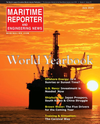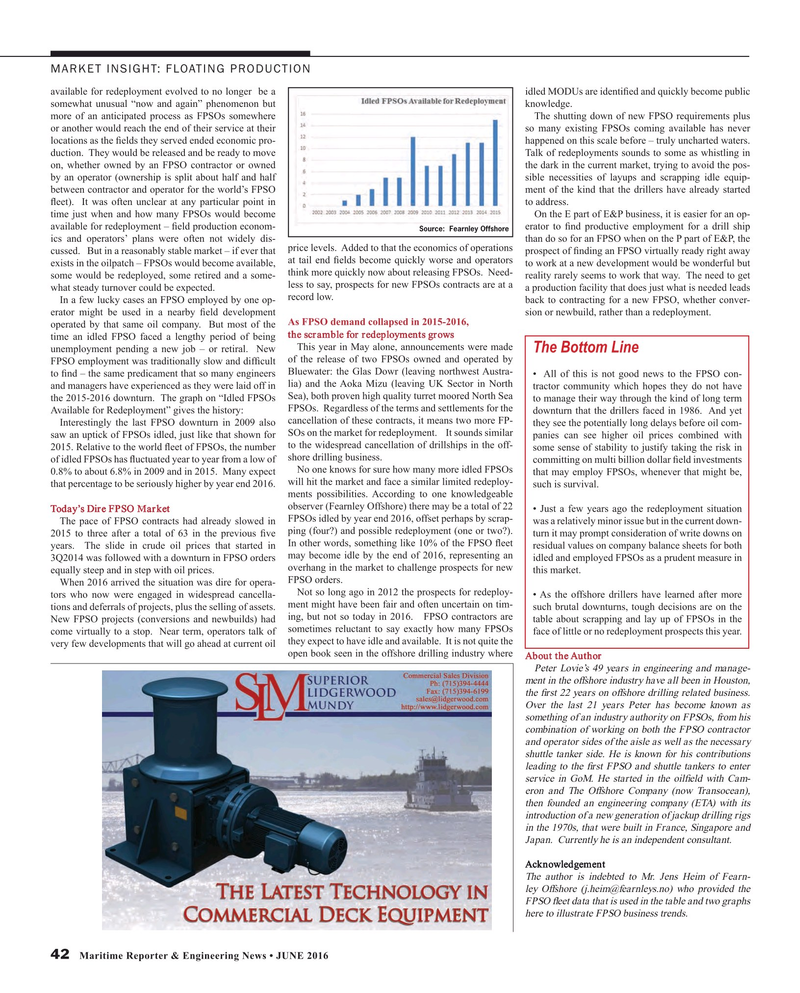
Page 42: of Maritime Reporter Magazine (June 2016)
Annual World Yearbook
Read this page in Pdf, Flash or Html5 edition of June 2016 Maritime Reporter Magazine
MARKET INSIGHT: FLOATING PRODUCTION available for redeployment evolved to no longer be a idled MODUs are identi? ed and quickly become public somewhat unusual “now and again” phenomenon but knowledge.
more of an anticipated process as FPSOs somewhere The shutting down of new FPSO requirements plus or another would reach the end of their service at their so many existing FPSOs coming available has never locations as the ? elds they served ended economic pro- happened on this scale before – truly uncharted waters. duction. They would be released and be ready to move Talk of redeployments sounds to some as whistling in on, whether owned by an FPSO contractor or owned the dark in the current market, trying to avoid the pos- by an operator (ownership is split about half and half sible necessities of layups and scrapping idle equip- between contractor and operator for the world’s FPSO ment of the kind that the drillers have already started ? eet). It was often unclear at any particular point in to address.
time just when and how many FPSOs would become On the E part of E&P business, it is easier for an op- available for redeployment – ? eld production econom- erator to ? nd productive employment for a drill ship
Source: Fearnley Offshore ics and operators’ plans were often not widely dis- than do so for an FPSO when on the P part of E&P, the price levels. Added to that the economics of operations cussed. But in a reasonably stable market – if ever that prospect of ? nding an FPSO virtually ready right away exists in the oilpatch – FPSOs would become available, at tail end ? elds become quickly worse and operators to work at a new development would be wonderful but think more quickly now about releasing FPSOs. Need- some would be redeployed, some retired and a some- reality rarely seems to work that way. The need to get what steady turnover could be expected. less to say, prospects for new FPSOs contracts are at a a production facility that does just what is needed leads record low.
In a few lucky cases an FPSO employed by one op- back to contracting for a new FPSO, whether conver- erator might be used in a nearby ? eld development sion or newbuild, rather than a redeployment. operated by that same oil company. But most of the As FPSO demand collapsed in 2015-2016, time an idled FPSO faced a lengthy period of being the scramble for redeployments grows
This year in May alone, announcements were made unemployment pending a new job – or retiral. New
The Bottom Line
FPSO employment was traditionally slow and dif? cult of the release of two FPSOs owned and operated by to ? nd – the same predicament that so many engineers Bluewater: the Glas Dowr (leaving northwest Austra- • All of this is not good news to the FPSO con- and managers have experienced as they were laid off in lia) and the Aoka Mizu (leaving UK Sector in North tractor community which hopes they do not have the 2015-2016 downturn. The graph on “Idled FPSOs Sea), both proven high quality turret moored North Sea to manage their way through the kind of long term
FPSOs. Regardless of the terms and settlements for the
Available for Redeployment” gives the history: downturn that the drillers faced in 1986. And yet
Interestingly the last FPSO downturn in 2009 also cancellation of these contracts, it means two more FP- they see the potentially long delays before oil com- saw an uptick of FPSOs idled, just like that shown for SOs on the market for redeployment. It sounds similar panies can see higher oil prices combined with 2015. Relative to the world ? eet of FPSOs, the number to the widespread cancellation of drillships in the off- some sense of stability to justify taking the risk in shore drilling business. of idled FPSOs has ? uctuated year to year from a low of committing on multi billion dollar ? eld investments
No one knows for sure how many more idled FPSOs 0.8% to about 6.8% in 2009 and in 2015. Many expect that may employ FPSOs, whenever that might be, will hit the market and face a similar limited redeploy- that percentage to be seriously higher by year end 2016. such is survival.
ments possibilities. According to one knowledgeable observer (Fearnley Offshore) there may be a total of 22
Today’s Dire FPSO Market • Just a few years ago the redeployment situation was a relatively minor issue but in the current down-
The pace of FPSO contracts had already slowed in FPSOs idled by year end 2016, offset perhaps by scrap- turn it may prompt consideration of write downs on 2015 to three after a total of 63 in the previous ? ve ping (four?) and possible redeployment (one or two?). residual values on company balance sheets for both years. The slide in crude oil prices that started in In other words, something like 10% of the FPSO ? eet idled and employed FPSOs as a prudent measure in 3Q2014 was followed with a downturn in FPSO orders may become idle by the end of 2016, representing an overhang in the market to challenge prospects for new equally steep and in step with oil prices. this market.
FPSO orders.
When 2016 arrived the situation was dire for opera-
Not so long ago in 2012 the prospects for redeploy- tors who now were engaged in widespread cancella- • As the offshore drillers have learned after more ment might have been fair and often uncertain on tim- tions and deferrals of projects, plus the selling of assets. such brutal downturns, tough decisions are on the table about scrapping and lay up of FPSOs in the
New FPSO projects (conversions and newbuilds) had ing, but not so today in 2016. FPSO contractors are face of little or no redeployment prospects this year.
come virtually to a stop. Near term, operators talk of sometimes reluctant to say exactly how many FPSOs very few developments that will go ahead at current oil they expect to have idle and available. It is not quite the open book seen in the offshore drilling industry where About the Author
Peter Lovie’s 49 years in engineering and manage- ment in the offshore industry have all been in Houston, the ? rst 22 years on offshore drilling related business.
Over the last 21 years Peter has become known as something of an industry authority on FPSOs, from his combination of working on both the FPSO contractor and operator sides of the aisle as well as the necessary shuttle tanker side. He is known for his contributions leading to the ? rst FPSO and shuttle tankers to enter service in GoM. He started in the oil? eld with Cam- eron and The Offshore Company (now Transocean), then founded an engineering company (ETA) with its introduction of a new generation of jackup drilling rigs in the 1970s, that were built in France, Singapore and
Japan. Currently he is an independent consultant.
Acknowledgement
The author is indebted to Mr. Jens Heim of Fearn- ley Offshore ([email protected]) who provided the
FPSO ? eet data that is used in the table and two graphs here to illustrate FPSO business trends.
42 Maritime Reporter & Engineering News • JUNE 2016
MR #6 (42-49).indd 42 6/7/2016 3:55:17 PM

 41
41

 43
43
